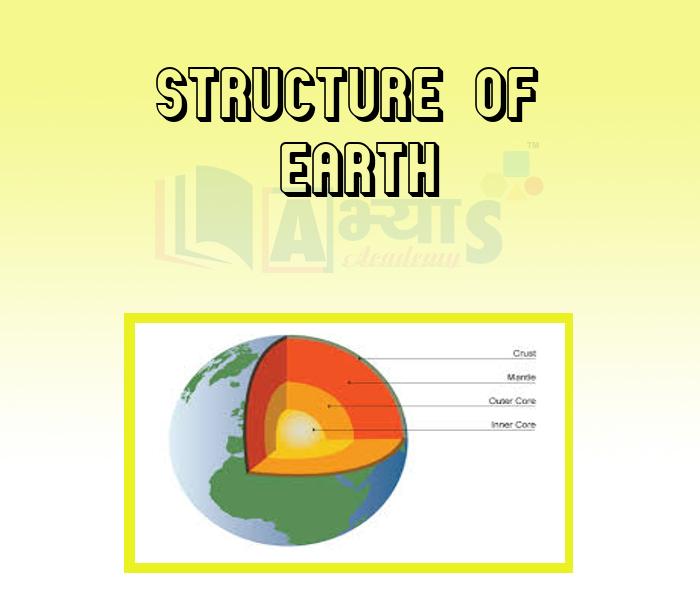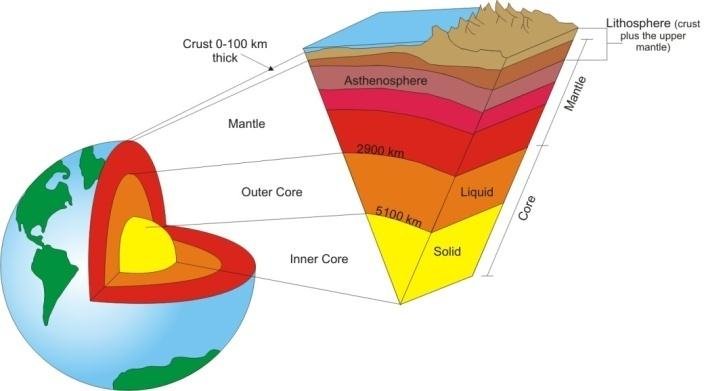Structure of Earth





Structure of Earth
Structure of Earth: Earth consists of several layers, each layer having different physical properties.
Beneath Earth's crust is layer called the mantle. The upper part of the mantle is a rigid solid like the crust. For this reason, the crust and the upper mantle are together known as the lithosphere (litho means rock). The lithosphere forms Earth's tectonic plates.
Beneath the lithosphere, the rock of the mantle behaves as a 'plastic' solid. This means the rock is flexible and can flow very slowly, similar to plastic that has been heated. This 'plastic' layer of the mantle is known as the asthenosphere. The tectonic plastic 'float' on the asthenosphere and so can move slowly across it.
The middle is very hot, and becomes hotter as its depth increases. Some of this heat probably dates back to the formation of Earth. Some new heat is created by friction due to moving rocks and also to the decay of radioactive elements. The heat is continually passing from deep in the Earth to the surface.
The core of Earth is very dense and is composed mostly of iron and nickel. The inner core is solid, but the outer core is liquid and can flow, scientists believe this gives Earth its magnetic field.

Why do the plates move ? : - There are two main theories for hos the plates move on the asthenosphere. One is that plates are dragged along as the hot magma in the asthenosphere rises up and then flows under the plates, creating convection currents. As the liquid rock flows, the enough to move them. Figure 10.1.9 shows the convection currents that might carry the plates along.
The other theory is that gravity is involved in moving tectonic plates. This could happen in two very different ways :
The core of earth is composed of __________. | |||
| Right Option : A | |||
| View Explanation | |||
With increase in depth of the Earth, temperature _____________. | |||
| Right Option : A | |||
| View Explanation | |||
Which of the following layers form the lithosphere ? | |||
| Right Option : D | |||
| View Explanation | |||
Students / Parents Reviews [10]
My experience with Abhyas academy is very good. I did not think that my every subject coming here will be so strong. The main thing is that the online tests had made me learn here more things.

Hiya Gupta
8thAbout Abhyas metholodology the teachers are very nice and hardworking toward students.The Centre Head Mrs Anu Sethi is also a brilliant teacher.Abhyas has taught me how to overcome problems and has always taken my doubts and suppoeted me.

Shreya Shrivastava
8thA marvelous experience with Abhyas. I am glad to share that my ward has achieved more than enough at the Ambala ABHYAS centre. Years have passed on and more and more he has gained. May the centre flourish and develop day by day by the grace of God.

Archit Segal
7thIt has a great methodology. Students here can get analysis to their test quickly.We can learn easily through PPTs and the testing methods are good. We know that where we have to practice

Barkha Arora
10thIt was a good experience with Abhyas Academy. I even faced problems in starting but slowly and steadily overcomed. Especially reasoning classes helped me a lot.

Cheshta
10thIt was good as the experience because as we had come here we had been improved in a such envirnment created here.Extra is taught which is beneficial for future.

Eshan Arora
8thMy experience with Abhyas is very good. I have learnt many things here like vedic maths and reasoning also. Teachers here first take our doubts and then there are assignments to verify our weak points.

Shivam Rana
7thAbhyas is a complete education Institute. Here extreme care is taken by teacher with the help of regular exam. Extra classes also conducted by the institute, if the student is weak.

Om Umang
10thMy experience was very good with Abhyas academy. I am studying here from 6th class and I am satisfied by its results in my life. I improved a lot here ahead of school syllabus.

Ayan Ghosh
8thOne of the best institutes to develope a child interest in studies.Provides SST and English knowledge also unlike other institutes. Teachers are co operative and friendly online tests andPPT develope practical knowledge also.
